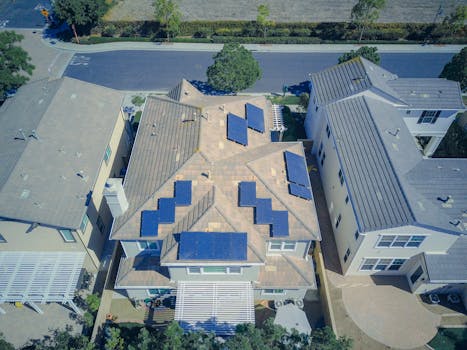“Power Up: Your Essential Guide to Preparing for Solar Battery Installation!”
Preparing for a solar battery installation involves several key steps to ensure a smooth and efficient process. First, assess your energy needs by reviewing your electricity consumption patterns and determining how much backup power you require. Next, research and select the appropriate solar battery system that fits your requirements, considering factors such as capacity, efficiency, and compatibility with your existing solar setup. It’s also essential to check local regulations and permits needed for installation. Additionally, prepare your installation site by ensuring adequate space and accessibility for the battery system. Finally, consult with a professional installer to discuss your plans and schedule the installation, ensuring all safety measures and best practices are followed.
Assessing Your Energy Needs
Preparing for a solar battery installation begins with a thorough assessment of your energy needs, a crucial step that lays the foundation for a successful and efficient system. Understanding your energy consumption patterns is essential, as it allows you to determine the appropriate size and capacity of the solar battery that will best serve your household or business. To start, you should review your past electricity bills, ideally over the course of a year, to identify trends in your energy usage. This will help you pinpoint peak usage times and seasonal variations, which are vital for calculating how much energy storage you will require.
Once you have a clear picture of your energy consumption, the next step is to consider your energy goals. Are you looking to reduce your reliance on the grid, achieve energy independence, or simply save on electricity costs? Each of these objectives may influence the type of solar battery system you choose. For instance, if your primary goal is to maximize savings, you may want to focus on a system that allows for time-of-use optimization, where you store energy during off-peak hours and use it during peak hours when rates are higher. Conversely, if energy independence is your goal, you might prioritize a larger battery capacity to ensure you have enough stored energy to cover your needs during outages or extended periods of low sunlight.
In addition to understanding your current energy needs, it is also important to anticipate future changes. Life events such as adding new family members, purchasing electric vehicles, or upgrading appliances can significantly impact your energy consumption. Therefore, it is wise to factor in potential increases in energy use when sizing your solar battery system. This foresight can prevent the need for costly upgrades or additional installations down the line.
Moreover, evaluating your home’s energy efficiency can provide insights into how much energy you can save and how effectively a solar battery can meet your needs. Conducting an energy audit can help identify areas where you can improve efficiency, such as upgrading insulation, sealing leaks, or investing in energy-efficient appliances. By reducing your overall energy consumption, you may find that a smaller battery system is sufficient, which can lead to lower upfront costs and a quicker return on investment.
As you assess your energy needs, it is also beneficial to consider the specific characteristics of your location. Factors such as local climate, sunlight exposure, and grid reliability can all influence the performance of your solar battery system. For example, if you live in an area with frequent power outages, you may want to invest in a larger battery capacity to ensure you have enough backup power. On the other hand, if your region enjoys abundant sunlight, you might be able to rely more on solar generation and less on battery storage.
Finally, consulting with a professional installer can provide valuable insights tailored to your unique situation. They can help you analyze your energy needs in detail, recommend suitable battery options, and ensure that your system is designed to maximize efficiency and performance. By taking the time to thoroughly assess your energy needs and considering all relevant factors, you will be well-prepared for a solar battery installation that meets your requirements and supports your energy goals effectively.
Choosing the Right Solar Battery

When considering a solar battery installation, one of the most critical steps is choosing the right solar battery for your needs. The market offers a variety of options, each with distinct features, capacities, and technologies. To make an informed decision, it is essential to understand the different types of solar batteries available and how they align with your energy requirements.
First and foremost, it is important to familiarize yourself with the two primary types of solar batteries: lithium-ion and lead-acid. Lithium-ion batteries are increasingly popular due to their high energy density, longer lifespan, and lower maintenance requirements. They can efficiently store energy generated from solar panels, allowing homeowners to utilize this energy during peak demand times or when the sun isn’t shining. On the other hand, lead-acid batteries, while generally more affordable upfront, tend to have a shorter lifespan and require more maintenance. Understanding these differences will help you weigh the initial costs against long-term benefits.
In addition to battery type, capacity is another crucial factor to consider. Battery capacity, measured in kilowatt-hours (kWh), indicates how much energy a battery can store. To determine the appropriate capacity for your home, you should assess your energy consumption patterns. Analyzing your electricity bills over the past year can provide insights into your average daily usage. By calculating your peak demand and considering any future energy needs, such as the addition of electric vehicles or home expansions, you can select a battery that meets your requirements without overcommitting financially.
Moreover, it is essential to consider the depth of discharge (DoD) of the battery. The DoD refers to the percentage of the battery that can be safely discharged without damaging it. For instance, a battery with a DoD of 80% allows you to use 80% of its total capacity, while a battery with a DoD of 50% restricts you to only half of its capacity. Choosing a battery with a higher DoD can maximize your usable energy, making it a more efficient option for your home.
Another important aspect to evaluate is the battery’s round-trip efficiency, which measures how much energy is lost during the charging and discharging process. A higher round-trip efficiency means that more of the stored energy can be used, ultimately leading to cost savings and improved performance. When comparing different batteries, look for those with efficiencies above 90%, as they will provide better value over time.
Furthermore, consider the warranty and lifespan of the battery. A longer warranty often indicates a manufacturer’s confidence in their product, and it can provide peace of mind for homeowners. Most lithium-ion batteries come with warranties ranging from 10 to 15 years, while lead-acid batteries typically have shorter warranties. Understanding the expected lifespan of the battery will help you plan for future replacements and budget accordingly.
Lastly, it is advisable to consult with a professional installer who can assess your specific situation and recommend the best battery options tailored to your needs. They can provide insights into local incentives, installation costs, and any potential upgrades to your solar system that may enhance performance. By taking the time to thoroughly research and evaluate your options, you can ensure that your solar battery installation is a sound investment that will provide reliable energy storage for years to come.
Preparing Your Home for Installation
Preparing your home for a solar battery installation is a crucial step that can significantly influence the efficiency and effectiveness of your new energy system. As you embark on this journey toward sustainable energy, it is essential to take a few preparatory measures to ensure a smooth installation process. First and foremost, assessing your current electrical system is vital. This involves checking your home’s wiring and electrical panel to ensure they can handle the additional load that a solar battery will introduce. If your electrical system is outdated or insufficient, it may require upgrades before the installation can proceed. Consulting with a qualified electrician can provide clarity on what modifications, if any, are necessary.
In addition to evaluating your electrical system, it is important to consider the physical space where the solar battery will be installed. Solar batteries are typically housed in a garage, basement, or utility room, so identifying a suitable location is essential. The chosen area should be dry, well-ventilated, and easily accessible for maintenance and monitoring. Furthermore, it is advisable to ensure that the space is free from any potential hazards, such as excessive moisture or extreme temperatures, which could affect the battery’s performance and longevity.
Once you have determined the appropriate location, the next step is to clear the area of any clutter or obstacles. This not only facilitates a more efficient installation process but also ensures that the technicians have ample space to work safely. Additionally, if you have pets or small children, it may be wise to make arrangements for their safety during the installation. Keeping the installation area clear and organized will help the technicians complete their work more quickly and effectively.
Moreover, it is essential to communicate with your solar battery installation company about any specific requirements or preferences you may have. This includes discussing the type of battery you have chosen, as different models may have unique installation needs. By having an open line of communication with your installer, you can address any concerns and ensure that the installation aligns with your expectations.
As you prepare for the installation, it is also beneficial to familiarize yourself with the operation and maintenance of your new solar battery system. Understanding how the system works will not only help you maximize its efficiency but also enable you to troubleshoot minor issues that may arise in the future. Many manufacturers provide user manuals and online resources that can guide you through the basics of operating and maintaining your solar battery.
Finally, it is wise to consider the potential impact of the installation on your daily routine. While most installations are completed within a day, it is prudent to plan accordingly. This may involve adjusting your schedule to accommodate the installation team or making arrangements for any disruptions to your power supply. By being proactive and prepared, you can minimize any inconvenience and ensure a seamless transition to your new solar battery system.
In conclusion, preparing your home for a solar battery installation involves a combination of assessing your electrical system, clearing the installation area, communicating with your installer, and familiarizing yourself with the new technology. By taking these steps, you can help ensure that the installation process is efficient and that your solar battery system operates at its best, ultimately contributing to a more sustainable energy future for your home.
Understanding Local Regulations and Incentives
When considering a solar battery installation, one of the first steps is to understand the local regulations and incentives that may impact your project. This understanding is crucial, as it can significantly influence both the feasibility and the financial viability of your solar energy system. Local regulations can vary widely from one jurisdiction to another, so it is essential to familiarize yourself with the specific rules that apply to your area.
To begin with, you should investigate zoning laws and building codes that pertain to solar installations. Many municipalities have specific guidelines regarding the placement and size of solar panels and batteries, which can affect where you can install your system. For instance, some areas may have restrictions on how close your installation can be to property lines or may require permits for certain types of installations. Therefore, consulting your local planning department or building authority can provide clarity on these regulations and help you avoid potential fines or complications down the line.
In addition to zoning laws, it is also important to understand the electrical codes that govern solar battery installations. These codes ensure that your system is safe and compliant with national and local standards. Engaging a licensed electrician who is familiar with solar installations can be beneficial, as they can help navigate these codes and ensure that your system is installed correctly. This not only guarantees safety but also enhances the longevity and efficiency of your solar battery system.
Moreover, many regions offer incentives to encourage the adoption of solar energy, which can significantly reduce the overall cost of your installation. These incentives may come in the form of tax credits, rebates, or grants, and they can vary based on state and local policies. For example, the federal solar tax credit allows homeowners to deduct a percentage of the cost of their solar system from their federal taxes, making it a valuable financial incentive. Additionally, some states have their own programs that provide further financial assistance, which can be particularly advantageous when combined with federal incentives.
To maximize your benefits, it is advisable to research and apply for these incentives early in the planning process. Many programs have specific application deadlines or require certain documentation, so being proactive can ensure that you do not miss out on potential savings. Websites dedicated to renewable energy resources or local government portals can be excellent starting points for finding information about available incentives in your area.
Furthermore, it is wise to connect with local solar energy organizations or community groups. These organizations often have valuable insights into the regulatory landscape and can provide guidance on navigating the installation process. They may also offer workshops or informational sessions that can help you better understand the benefits and challenges associated with solar battery installations.
In conclusion, preparing for a solar battery installation involves a thorough understanding of local regulations and available incentives. By familiarizing yourself with zoning laws, building codes, and electrical standards, you can ensure a compliant and safe installation. Additionally, taking advantage of financial incentives can make your solar project more affordable and sustainable. Engaging with local resources and experts can further enhance your knowledge and support you throughout the installation process, ultimately leading to a successful transition to solar energy.
Q&A
1. **What should I do before the installation date?**
Ensure that you have a clear area for the installation, free of debris and obstacles, and confirm that all necessary permits and approvals are in place.
2. **How can I assess my energy needs?**
Review your past electricity bills to determine your average usage and consider any future changes, such as adding appliances or electric vehicles.
3. **What equipment do I need to have ready?**
Make sure you have the appropriate solar battery system, inverter, and any necessary mounting hardware, as well as safety equipment like gloves and goggles.
4. **Should I inform my utility company?**
Yes, notify your utility company about the installation, as they may need to update your meter or provide guidelines for grid connection.
Conclusion
To prepare for a solar battery installation, first assess your energy needs and usage patterns to determine the appropriate battery size. Research and select a reputable installer with experience in solar battery systems. Ensure your home’s electrical system is compatible and up to code, and obtain any necessary permits. Clear the installation area and ensure easy access for the installers. Finally, review the warranty and maintenance requirements for the battery system to ensure long-term performance. Proper preparation will facilitate a smooth installation process and optimize the benefits of your solar battery system.




